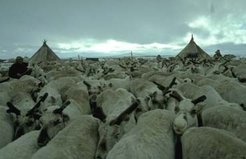Property and Economy among reindeer herders in Yamal, Northwest Siberia
Project Summary

The Yamal-Nenets Autonomous Okrug at the first glance looks like a success story in reindeer herding, continuing even in the difficult times of transformation after the Soviet Union. The number of domestic reindeer is constantly increasing, up to 523 000, which is the largest concentration in Russia and the world. Selling the main production of reindeer, meat and 'panty' (fresh antlers), is no problem for the herders, since private commercial enterprises compete with the still existing 'Sovkhozy' (state farms). Thus, reindeer herding provides a secure basis for economic existence and the indigenous cultural identity of the herders. Such a development is unique in the Post-Soviet Russian North, where reindeer herding in all other regions either collapsed or is experiencing a major crisis. It is even more remarkable, given that Yamal provides 90% of the Russian natural gas production and the share of the native population is only 5 %.
My dissertation project at the Max-Planck Institute with the working title “When nomads meet the market: Property and Economy among reindeer herders of Yamal, Northwest Siberia”, tries to look behind the facade of this “success story” , with particular attention being paid to the nature of property relations in land and animals among the Yamal-Nenets, and the way in which they engage in the evolving market economy of the region.

During a one year field research in the Yamalo-Nenetskii Autonomous Okrug (the official term for my field site region), I wanted to find out how this “success story” looks like at the grassroots, in the tundra and the Polar Ural mountains. In living with the nomadic reindeer herders and taking part in their interactions with the Russian sedentary population, the administration and the oil and gas industry, I wanted to discover the human and other basic components responsible for this development.
The tundra population of Yamal are Khanty, Komi, but mainly Nentsy reindeer herders, who migrate throughout the year with big herds of several thousand deer through the Tundra, the Forest-Tundra south to the arctric circle and the polar Ural mountains. Throughout the Russian North it is in this region, where reindeer herding is thought to be preserved in its most original way. This is mostly due to the Nentsy, and the Northern Khanty have partially adapted this herding style from them.
Rather than further contributing to further construct a “secret of the Nentsy”, how the origins of their success deeply lie in something called “their culture”, I try to put together a mosaic of all relevant factors outside and inside of these pastoralists’ world, which could in their combination be the reason for such an unusual development in the region.

